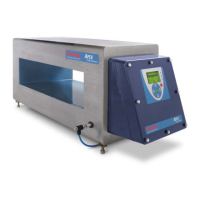Page 12 Thermo Scientific APEX User’s Guide
Managing Product-Rejection Parameters
Once the detector is up and running and detecting metal contaminants, the next task is
to set up the all-important product-rejection parameters, which fine tune the accept-or-
reject process for your products. Which parameters you use, however, depend on the
type of application (conveyor, gravity-feed, pipeline, or pharmaceutical) you are using.
• Conveyor Applications
In this application, a conveyor belt is used to pass the product through the
detector’s search head.
• Gravity-Feed (also known as “Drop-Through”) Applications
The search head surrounds a vertical duct where the product drops through the
duct under the influence of gravity. The detector’s search head is installed around
the outside of the duct.
• Pipeline Applications
The detector’s search head is installed surrounding a pipe, where product is
flowing under pressure.
• Pharmaceutical Applications
The search head surrounds a chute where the product drops through the chute
under the influence of gravity. The detector’s search head is installed around the
outside of the chute.
Choosing Your Application Type
Clearly, the product parameters and product-rejection parameters used by the APEX
vary depending on the type of application you are using. As a result, you should now go
to the specific section in this manual that explains the detailed set-up procedures for
your particular type of application. Find the relevant section as follows.
• Conveyor applications—Go to the page that follows this one (page 13).
• Gravity-feed applications—Go to page 63.
• Pipeline applications—Go to page 79.
• Pharmaceutical (Rx) applications—Go to page 95.

